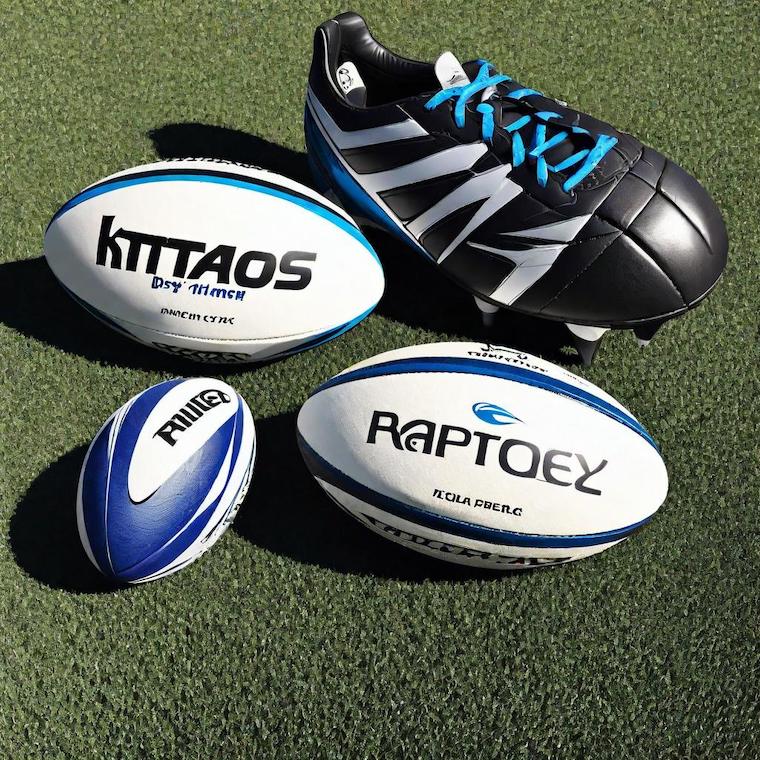In the dynamic and physically demanding sport of rugby, having the right equipment is crucial for both performance and safety on the field. From the ball that is passed with precision to the jersey that bears the team’s colors, every piece of gear plays a vital role in the game.
Let’s dive into the world of rugby equipment, exploring the essentials such as balls, jerseys, boots, and protective gear, and discover how they contribute to the excitement and intensity of the sport.
Rugby Balls
Rugby balls are at the heart of the game, and choosing the right one can significantly impact your performance. Here’s why selecting the right rugby ball matters and how to choose the best one for your needs:
- Choosing the Right Rugby Ball:
- Playing Conditions: Different playing conditions, such as weather and field type, can affect the choice of rugby ball. For wet conditions, a ball with better grip is essential, while for dry conditions, a ball with a smoother surface may be preferable.
- Types of Rugby Balls: There are various types of rugby balls, including match balls, training balls, and specialist balls for specific conditions (e.g., high-altitude balls). Each type has specific features designed for its intended use.
- Size, Grip, and Construction: When selecting a rugby ball, consider factors such as size, grip, and construction. The size of the ball should match the age and skill level of the players. A good grip is crucial for handling and passing, while the construction should be durable and suitable for the level of play.
- Types of Rugby Balls:
- Match Balls: Match balls are high-quality balls designed for use in official rugby matches. They are typically made of high-grade materials and offer excellent grip and flight characteristics.
- Training Balls: Training balls are designed for practice sessions and are often more durable than match balls. They may have a different feel or grip to match balls but are still suitable for honing skills and techniques.
- Tips for Selecting the Right Rugby Ball:
- Size: Rugby balls come in different sizes to suit different age groups and skill levels. Choose a ball that is appropriate for the player’s age and level of play.
- Grip: Look for a ball with a good grip that allows for easy handling and passing, especially in wet conditions.
- Construction: Consider the construction of the ball, including the materials used and the number of panels. A ball with fewer panels may offer better flight characteristics, while a ball with more panels may be more durable.
Rugby Jerseys
Rugby jerseys are more than just uniforms—they play a vital role in player comfort, team identity, and performance on the field. Here’s why selecting the right rugby jersey is crucial and how to choose the best one for your needs:
- Player Comfort and Team Identity:
- Comfort: Rugby jerseys are designed to be comfortable and durable, allowing players to move freely without restriction. They are typically made from breathable fabrics that wick away moisture to keep players dry and comfortable throughout the game.
- Team Identity: Rugby jerseys are a symbol of team identity, representing the colors and crest of the team. Wearing the team jersey instills a sense of pride and unity among players, enhancing team spirit and cohesion.
- Types of Rugby Jerseys:
- Replica Jerseys: Replica jerseys are designed for fans and supporters of the team. They are often made from lighter materials and may not have the same performance features as official team jerseys.
- Performance Jerseys: Performance jerseys are designed for players and are made from high-performance fabrics that offer moisture-wicking properties, durability, and flexibility. They are specifically designed to enhance player performance on the field.
- Choosing the Right Rugby Jersey:
- Fit: Choose a rugby jersey that fits comfortably without being too tight or too loose. A well-fitted jersey allows for freedom of movement and prevents discomfort during play.
- Material: Look for jerseys made from breathable, moisture-wicking fabrics that keep you cool and dry during intense play. Avoid jerseys that are made from heavy or non-breathable materials.
- Team Requirements: Consider any specific requirements or regulations set by your team or league regarding jersey design, color, or branding. Ensure that your chosen jersey meets these requirements.
Rugby Boots
Rugby boots are a vital piece of equipment, providing traction, support, and injury prevention on the field. Here’s why choosing the right rugby boots is crucial and how to select the best pair for your needs:
- Importance of Proper Footwear:
- Traction: Rugby boots are designed to provide traction on grass surfaces, allowing players to grip the ground and change direction quickly.
- Support: Rugby boots offer support for the ankles and feet, reducing the risk of sprains and other injuries.
- Injury Prevention: Wearing the right rugby boots can help prevent common rugby injuries, such as ankle sprains and turf toe.
- Types of Rugby Boots:
- Molded Studs: Molded stud boots have studs (cleats) that are permanently attached to the sole of the boot. They are suitable for playing on firm ground and provide good traction.
- Screw-In Studs: Screw-in stud boots allow players to change the length and configuration of the studs based on playing conditions. They are ideal for playing on soft or muddy surfaces.
- Selecting the Right Rugby Boots:
- Fit: Choose rugby boots that fit snugly but comfortably, with enough room for your toes to move freely. A good fit is essential for comfort and performance.
- Stud Configuration: Consider the stud configuration based on the playing surface. For firm ground, molded studs are suitable, while screw-in studs are better for soft or muddy surfaces.
- Position: Different positions may require different types of boots. For example, forwards may prefer boots with more ankle support, while backs may prefer lighter boots for speed and agility.
- Additional Tips:
- Try Before You Buy: It’s essential to try on rugby boots before purchasing them to ensure they fit properly and feel comfortable.
- Consider Your Playing Style: Your playing style and position on the field can also influence your choice of rugby boots. Forwards may prefer boots with more durability and protection, while backs may prioritize speed and agility.
Protective Gear in Rugby
Protective gear is essential in rugby to reduce the risk of injury and ensure player safety on the field. Here’s an overview of the essential protective gear in rugby and how to select the right gear for your needs:
- Headgear: Headgear is designed to protect players from head injuries, including cuts, bruises, and concussions. It is especially important for players in positions where head-to-head contact is common, such as forwards in scrums. Look for headgear that is comfortable, provides good coverage, and meets safety standards.
- Mouthguards: Mouthguards protect the teeth, gums, and jaws from impact during tackles and collisions. They are essential for all players, regardless of position. Choose a mouthguard that fits well and offers adequate protection for your teeth and mouth.
- Shoulder Pads: Shoulder pads are worn to protect the shoulders and upper body from impact during tackles and collisions. They can also help prevent shoulder injuries. Select shoulder pads that fit comfortably and provide adequate protection without restricting movement.
- Protective Clothing: Also, players may wear protective clothing such as padded shorts or shirts to protect against impact and abrasions. These can be especially useful for players in positions that are prone to contact, such as forwards.
- Importance of Protective Gear: Protective gear is crucial in rugby to reduce the risk of serious injury. While no gear can completely eliminate the risk of injury, wearing the right protective gear can significantly reduce the severity of injuries.
- Selecting the Right Protective Gear: When selecting protective gear, consider your position, level of play, and personal preference. For example, forwards may require more robust gear due to the physical nature of their position, while backs may prefer lighter gear for mobility.
- Safety Standards: Ensure that any protective gear you purchase meets safety standards and is approved for use in rugby. This will help ensure that the gear provides adequate protection against common injuries.
Care and Maintenance of Rugby Equipment
Proper care and maintenance of your rugby equipment are essential for prolonging its lifespan and maintaining optimal performance on the field. Here are some guidelines for caring for your rugby gear:
- Rugby Balls:
- Cleaning: Wipe down your rugby ball with a damp cloth after each use to remove dirt and debris. Avoid using harsh chemicals or abrasive materials, as they can damage the ball.
- Storage: Store your rugby ball in a cool, dry place away from direct sunlight and heat. Avoid storing it in damp or humid conditions, as this can cause the ball to deteriorate.
- Rugby Jerseys:
- Washing: Wash your rugby jersey according to the manufacturer’s instructions to maintain its color and shape. Use a mild detergent and cold water, and avoid using bleach or fabric softener.
- Drying: Air dry your rugby jersey by laying it flat or hanging it on a clothesline. Avoid using a dryer, as the heat can damage the fabric.
- Rugby Boots:
- Cleaning: Clean your rugby boots after each use to remove mud and dirt. Use a soft brush or cloth to gently scrub the boots, and avoid using harsh chemicals that can damage the material.
- Drying: Allow your rugby boots to air dry naturally after cleaning. Avoid using a dryer or placing them near a heat source, as this can cause the material to crack or shrink.
- Protective Gear:
- Cleaning: Clean your protective gear regularly to remove sweat and bacteria. Follow the manufacturer’s instructions for cleaning each specific piece of gear.
- Storage: Store your protective gear in a well-ventilated area to allow it to dry completely between uses. Avoid storing it in a closed, damp environment, as this can lead to mold and mildew growth.
- General Maintenance:
- Inspect regularly: Regularly inspect your rugby equipment for signs of wear and tear, such as frayed seams or loose stitching. Replace any damaged gear to ensure your safety and performance on the field.
- Rotate gear: If you have multiple sets of gear, such as jerseys or boots, consider rotating them to prolong their lifespan. This can also help prevent excessive wear on any one set of gear.
Conclusion
In conclusion, choosing the right rugby equipment is essential for both performance and safety on the field. Rugby balls, jerseys, boots, and protective gear all play a crucial role in the game, providing comfort, protection, and performance-enhancing features.
Selecting high-quality rugby equipment that fits well and meets your specific needs can greatly enhance your performance and enjoyment of the game. Proper care and maintenance of your gear are also important for prolonging its lifespan and ensuring it remains in top condition.
As you continue your rugby journey, remember to invest in high-quality equipment and take care of it properly. Your gear is not just a uniform but a crucial part of your performance and safety on the field. With the right equipment and mindset, you can play your best game and enjoy all that rugby has to offer.




